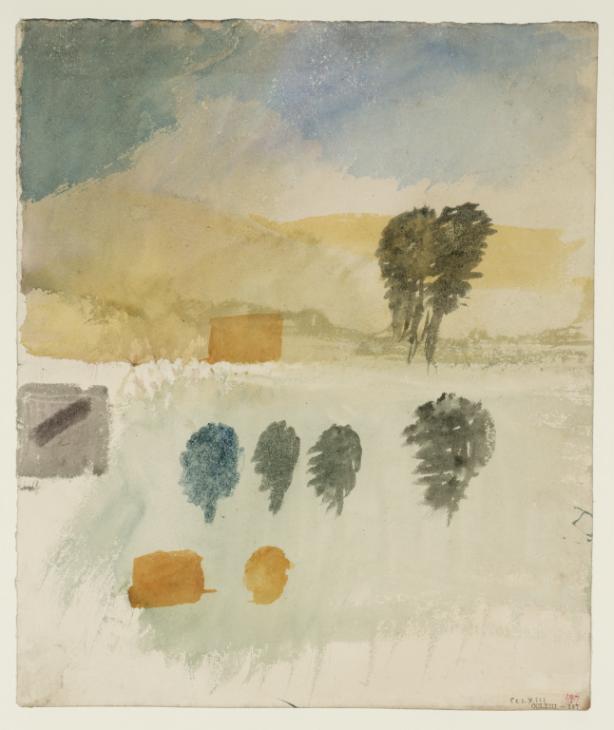Joseph Mallord William Turner Hills and Trees: ?A Paper Test c.1820-30
Joseph Mallord William Turner,
Hills and Trees: ?A Paper Test
c.1820-30
Joseph Mallord William Turner 1775–1851
Hills and Trees: ?A Paper Test c.1820–30
D25420
Turner Bequest CCLXIII 297
Turner Bequest CCLXIII 297
Watercolour on white wove paper, 265 x 222 mm
Inscribed in pencil ‘CCLXIII’ and in red ink ‘297’ bottom right
Stamped in black ‘CCLXIII – 297’ bottom right
Inscribed in pencil ‘CCLXIII’ and in red ink ‘297’ bottom right
Stamped in black ‘CCLXIII – 297’ bottom right
Accepted by the nation as part of the Turner Bequest 1856
Exhibition history
1997
Turner’s Watercolour Explorations 1810–1842, Tate Gallery, London, February–June 1997, Southampton City Art Gallery, June–September (8, reproduced in colour, as ‘?A Paper Test’, ?1820s).
2009
Colour and Line: Turner’s Experiments [fourth hang], Tate Britain, London, December 2009–April 2013 (no catalogue).
2015
Risk, Turner Contemporary, Margate, October 2015–January 2016 (no catalogue).
References
1820
A.J. Finberg, A Complete Inventory of the Drawings of the Turner Bequest, London 1909, vol.II, p.837, CCLXIII 297, as ‘An experiment with trees’, c.1820–30.
1975
Gerald Wilkinson, Turner’s Colour Sketches 1820–34, London 1975, reproduced in colour p.110.
1820
Eric Shanes, Turner’s Watercolour Explorations 1810–1842, exhibition catalogue, Tate Gallery, London 1997, pp.11, 30, 38–9 no.8, reproduced in colour, as ‘?A Paper Test’, ?1820s, p.100 Appendix I ‘Paper Test-Sheets?’.
This sheet effectively comprises two halves, with a conventional if slight landscape of trees and a red rectangular structure against hills and a stormy sky at the top, and isolated tree shapes and patches of colour over a grey wash at the bottom. Gerald Finberg observed how some of Finberg’s more idiosyncratic titles in the 1909 Inventory, such as ‘An experiment with trees’ here,1 had led the art historian Christian Geelhaar to compare Turner’s work to that of the Swiss-German Modernist artist Paul Klee (1879–1940),2 although Wilkinson dismissed such formalist connections as ‘tenuous’. Instead he suggested that the ‘somewhat trite little landscape in very clear, sweet colours’ might have been made as a demonstration of ‘economically overlaid washes for a pupil, were it not for Turner’s one-to-one teaching being limited to the early part of his career3 (see the ‘Copy-Drawings 1794–8’ section of the present catalogue).
The Turner scholar and artist Eric Shanes has conducted a very thorough analysis of Turner’s approach in this work, categorising it as one of a dozen ‘Paper Test-Sheets’ among the ‘colour beginnings’,4 which were ‘given over to the investigation of brushwork effects, the diffusion of colours, paper characteristics and the like. Usually the test sheets can be identified by their imagery (or lack of it), or by some technical detail that was obviously of primary interest to the artist.’5 They may have been occasioned by Turner’s acquisition of new types of paper, and in this case ‘the extreme formalisation of the image – not for nothing has it been likened to a Paul Klee – suggests strongly that Turner tested the sheet with dabs, washes and further overlays of colour, and was not overly concerned with his imagery while doing so.’6 Nevertheless, ‘perhaps Turner was loath just to test dabs of colour unrelated to any imagery, and so he created an improvisatory but fragmented composition.’7
Although it is relatively small, the effective division of the paper into two equal working areas is consistent with Turner working on more than one design at the same time, sometimes within the same sheet and subsequently divided.8 Indeed, two of the works in this section (Tate D25498, D25499; Turner Bequest CCLXIII 375a, 375b) remain together as unrelated compositions one above the other. The present work has been dated here to about 1820–30 in line with Shanes’s ‘?1820s’.
There are numerous sketchbook pages and the versos of separate sheets from earlier in Turner’s career, where he tested his colours extensively if somewhat less methodically, for example in the 1791 Bristol and Malmesbury sketchbook (Tate D00081; Turner Bequest VI 8) and the 1794 Matlock sketchbook (Tate D40750; Turner Bequest XIX, inside the front cover).
Technical notes:
The following colour notes closely paraphrase Eric Shanes’s intensive observations.1 The landscape was composed over a grey wash using cobalt (or smalt) and ultramarine blues in the sky, with the latter pigment appearing speckled or marbled. Naples yellow and gamboge (deep yellow) are used, and gamboge also constitute the patches in the lower half of the sheet. The trees within the landscape use green with black (or indigo) over an olive green which had spread into the washes of the hills.
The lower half was begun with a rough ‘slightly bluish Naples-yellow wash’,2 with the four isolated trees in speckled blue-black and green-black, and in more of the same colour used in the landscape above. The square at the centre left, possibly of Payne’s grey, had a darker stroke superimposed while damp, causing some diffusion.
A vertical fold at is evident at the middle of the sheet.
Matthew Imms
December 2015
How to cite
Matthew Imms, ‘Hills and Trees: ?A Paper Test c.1820–30 by Joseph Mallord William Turner’, catalogue entry, December 2015, in David Blayney Brown (ed.), J.M.W. Turner: Sketchbooks, Drawings and Watercolours, Tate Research Publication, November 2016, https://www

